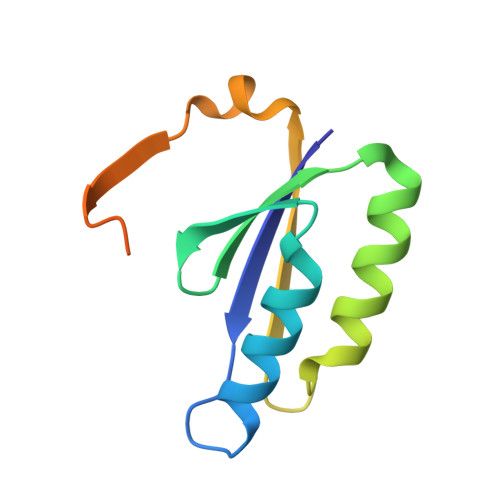Structural and dynamic insights into the role of conformational switching in the nuclease activity of the Xanthomonas albilineans Cas2 in CRISPR-mediated adaptive immunity
Ka, D., Hong, S., Jeong, U., Jeong, M., Suh, N., Suh, J.Y., Bae, E.(2017) Struct Dyn 4: 054701-054701
- PubMed: 28612041
- DOI: https://doi.org/10.1063/1.4984052
- Primary Citation of Related Structures:
5H1O, 5H1P - PubMed Abstract:
Clustered regularly interspaced short palindromic repeats (CRISPRs) and CRISPR-associated (Cas) proteins constitute a microbial, adaptive immune system countering invading nucleic acids. Cas2 is a universal Cas protein found in all types of CRISPR-Cas systems, and its role is implicated in new spacer acquisition into CRISPR loci. In subtype I-C CRISPR-Cas systems, Cas2 proteins are metal-dependent double-stranded DNA (dsDNA) nucleases, and a pH-dependent conformational transition has been proposed as a prerequisite for catalytic action. Here, we report the crystal structure of Xanthomonas albilineans Cas2 (XaCas2) and provide experimental evidence of a pH-dependent conformational change during functional activation. XaCas2 crystallized at an acidic pH represented a catalytically inactive conformational state in which two Asp8 residues were too far apart to coordinate a single catalytic metal ion. Consistently, XaCas2 exhibited dsDNA nuclease activity only under neutral and basic conditions. Despite the overall structural similarity of the two protomers, significant conformational heterogeneity was evident in the putative hinge regions, suggesting that XaCas2 engages in hinge-bending conformational switching. The presence of a Trp residue in the hinge region enabled the investigation of hinge dynamics by fluorescence spectroscopy. The pH dependence of the fluorescence intensity overlapped precisely with that of nuclease activity. Mutational analyses further suggested that conformational activation proceeded via a rigid-body hinge-bending motion as both D8E and hinge mutations significantly reduced nuclease activity. Together, our results reveal strong correlations between the conformational states, catalytic activity, and hinge dynamics of XaCas2, and provide structural and dynamic insights into the conformational activation of the nuclease function of Cas2.
- Department of Agricultural Biotechnology, Seoul National University, Seoul 08826, South Korea.
Organizational Affiliation:

















